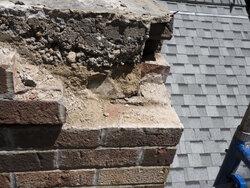Squisher
Minister of Fire
I am always very reluctant/cautious to trust my life to a masonry chimney. Some can be a lot more wiggly then they look at first glance.
Exactly what my point was from the start. When you work on chimneys all the time you learn not to trust anything.I am always very reluctant/cautious to trust my life to a masonry chimney. Some can be a lot more wiggly then they look at first glance.
The brick institute no longer recomend metal reinforcement in crowns. Fiber reinforced concrete is prefered
Yes use fiber not mesh. I dont know anything about the premixed stuff i have always mixed my own.So does this mean if I use Fiber reinforced concrete I should NOT use wire mesh or rebar?
Is this the stuff: https://www.homedepot.com/p/Quikrete-80-lb-Crack-Resistant-Concrete-100680/100318448
Myself and partner witness it.We were stun.The roller knocked a brick out of the chimney.Sounds crazy.It was crazyI'm missing something.
How can a chimney that can withstant Eastern MA winds ( 70 MPH+) fail in the presence of a paint roller? How did a paint roller go " through the outside of the chimney brick"?
On youtube there's all types of riggings used to work on chimneys that keep one from putting weight on the chimney.I will never put my weight on a chimney.They can look strong but don't trust it.Invest in safe rigging.

Because the brick structure the clay liners and the concrete crown all expand at different rates. Over time this can cause damage.Does anybody know why the need for a bond break is never mentioned when pouring a non-overhanging concrete crown (see previous post picture) ? Is it because non-overhanging crowns are not usually done with concrete and i have an unusual setup?
It shouldnt be done that way there is no way to do that correctly.I have a poured concrete crown but its inside the brick and not overhanging.
Its just feathered using concrete to the brick edge. How should you do a bond break on that?
Should I feather the concrete using mortar on top of the brick?
Most masons dont do proper crowns and that is why we spend all summer rebuilding the tops of chimneys many of them only 15 to 20 years old. Wash crowns simply are not very durable. And mortar that is to hard causes just as many if not more problems than soft mortar.A bricklayer I once knew would lay the top several courses in a mortar with a higher portland ratio and less sand and a feathered cap of the same strong mix. Something about the more sand the more water it would be prone to absorb. He had his own special "recipe" for it. He humped it in the center and sloped it to the brick's edge for runoff. He never poured an overhanging cap unless the house designer specifically called for one. He built probably thousands of chimneys in the most upscale developments over his career. A thick overhanging cap is quite rare in these parts actually.
Most masons dont do proper crowns and that is why we spend all summer rebuilding the tops of chimneys many of them only 15 to 20 years old. Wash crowns simply are not very durable. And mortar that is to hard causes just as many if not more problems than soft mortar.
Needed yes but there is no way to do it and keep the crown water tight. This is why wash crowns usually fail around the edge. And or crack from the corners of the clay liner.Is a bond break with the brick needed when the crown is done with a mortar wash?
Yes the thinnest part and allot of stress thereMakes sense. That's where my crown failed and mine was a "concrete wash".

